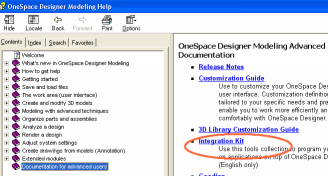-
Edit -
Attach - Printable
CoCreate Modeling FAQ: Learning Lisp
 Where can I learn more about Lisp?
Where can I learn more about Lisp?
CoCreate Modeling's implementation of Lisp is based on Common Lisp for which you will find numerous
resources on the Internet - see the section on Lisp Programming
in the list of References and Links.
There is, of course, also lots of "paperware" on Lisp:
- German books on Lisp (Amazon search query)
- English books on Lisp (Amazon search query)
 Wo kann ich mehr über Lisp lernen?
Wo kann ich mehr über Lisp lernen?
Die Implementierung von Lisp in CoCreate Modeling basiert auf Common Lisp, wofür
man im Internet zahllose Hilfestellungen findet - siehe
den Abschnitt zur Lisp-Programmierung
in der Verweisliste.
Es gibt natürlich auch eine Menge gedruckter Informationen zu Lisp:
- Deutsche Bücher über Lisp (Amazon-Suchanfrage)
- Englische Bücher über Lisp (Amazon-Suchanfrage)
 Where do I find information and documentation about how to programmatically extend CoCreate Modeling?
Where do I find information and documentation about how to programmatically extend CoCreate Modeling?
 Here are a few hints and links which will hopefully get you started:
Here are a few hints and links which will hopefully get you started:
- First and foremost, make sure that you read the documentation on the Integration Kit which is shipped and installed with every copy of CoCreate Modeling. To view the documentation in OneSpace Modeling 2004, go to the Help menu, choose "Help on Product". This opens the documentation overview page. Scroll down to the section "OneSpace Designer Modeling Advanced Topics" and click on "OneSpace Designer Developers Kit". In OneSpace Modeling 2005, go the Help menu and choose "Help Topics". In the overview page, choose "Supplementary and advanced documentation", then "Integration Kit".
- The second document which you absolutely should read is the Customization Guide in the online documentation. To view this guide in OneSpace Modeling 2004, go to the Help menu, choose "Help on Product". This opens the documentation overview page. Scroll down to the section "OneSpace Designer Modeling Advanced Topics" and click on "Customization Guide". In OneSpace Modeling 2005, go the Help menu and choose "Help Topics". In the overview page, choose "Supplementary and advanced documentation", then "Customization Guide".
- The German user web site at http://osd.cad.de has examples of extensions and macros for download from which you can learn.
- More examples can be found at OsdmMacros.
 Wo finde ich Informationen darüber, wie man CoCreate Modeling programmatisch erweitert?
Wo finde ich Informationen darüber, wie man CoCreate Modeling programmatisch erweitert?
Ein paar Hinweise und Verweise, die hoffentlich den Stein ins Rollen bringen:
- Zuallererst: Die Dokumentation zum "Integration Kit", das mit jeder Kopie von CoCreate Modeling mit ausgeliefert wird, sollte man unbedingt studiert haben. Zu dieser Dokumentation gelangt man in OneSpace Modeling 2004 über das "Hilfe"-Menü; dort wählt man "Zu Produkt" aus. Damit kommt man zur Übersichtsseite der vorhandenen Dokumentation. Wenn man vorwärtsblättert, gelangt man zum Abschnitt "OneSpace Designer Modeling Advanced Topics", wo man auf "OneSpace Designer Developers Kit" klickt. In OneSpace Modeling 2005 wählt man im "Hilfe"-Menü den Eintrag "Help Topics". Auf der Übersichtsseite wählt man "Supplementary and advanced documentation", dann "Integration Kit".
- Das zweite Dokument, das man unbedingt lesen sollte, ist der "Customization Guide" in der Online-Hilfe. In OneSpace Modeling 2004 geht man dazu ins "Hilfe"-Menü und wählt "Zu Produkt". Dann bis zum Abschnitt "OneSpace Designer Modeling Advanced Topics" vorwärtsblättern und auf "Customization Guide" klicken. In OneSpace Modeling 2005 wählt man im "Hilfe"-Menü "Help Topics" aus, und gelangt über den Eintrag "Supplementary and advanced documentation" der Übersichtsseite zum "Customization Guide".
- Im Internet gibt es unter http://osd.cad.de Beispiele für Erweiterungen und Makros, die man auch von dort herunterladen kann.
- Unter OsdmMacros finden sich weitere Beispiele.
 Where I can find sample code to learn from?
Where I can find sample code to learn from?
See the section on macros in the list of
References and links.
Often overlooked, but a great source of inspiration: The code
examples in the Integration Kit documentation (see above
on how to find the documentation).
 Wo finde ich Lisp-Code, von dem ich lernen kann?
Wo finde ich Lisp-Code, von dem ich lernen kann?
Siehe den Abschnitt zu Makros in der Liste der
Verweise.
Oft übersehen, aber eine prima Quelle der Inspiration: Die
Beispielprogramme in der Dokumentation zum Integration Kit
(siehe die Hinweise weiter oben
zum Auffinden der Dokumentation).
-- ClausBrod, last updated 2007/04/05
to top
Revisions: | r1.8 | > | r1.7 | > | r1.6 | Total page history | Backlinks
 CoCreateModeling
CoCreateModeling